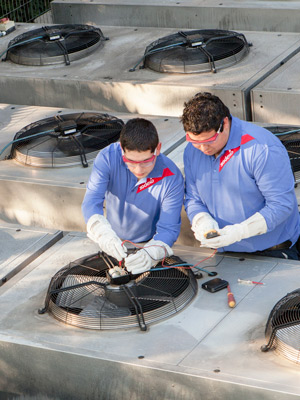Nearly every organization needs or wants to achieve more with its assets. Not only how to minimize downtime or lost production, but also how to spend money well to deliver value for the purpose of the organization.
In the last few years, many companies have begun to realize the importance of asset management as an enterprise strategy that, properly implemented, will improve financial performance. Typical results of an asset management system include improved control of day-to-day activities and business efficiencies, reduction of risk-related costs, compliance in regulatory activities and reduced failure rates. The tangible results include a significant increase in profitability accompanied by a dramatic drop in unit cost.

In their paper “Quantified Benefits from Asset Management – The Sodexo Journey”, Peter Jay, Principal Consultant at the Woodhouse Partnership Ltd, and Keith Hamer, Group Vice-President, Asset Management & Engineering, at Sodexo, explain how the company implemented ISO 55001 and transformed their business, to enable growth and improve value to their customers.
Sodexo, world leader in quality-of-life services, has become one of the first services provider to offer a global asset management service in compliance with ISO 55001. At the end of a two-year journey, the company has received the accreditation for its global asset management framework and for the application of the framework at AstraZenecaʼs UK sites of Alderley Park and Macclesfield, with which it enjoys a strategic partnership.
Sodexo is leading the way in offering comprehensive asset management capabilities globally and to clients in diverse segments ranging from corporate and healthcare, to manufacturing, mining, and oil and gas. And the results are promising! Here, we share the main findings of Sodexoʼs journey to impressive financial performance.
Background

In 2011, 77 % of Sodexoʼs business was the provision of food services while the remaining 23 % was other services (including EUR 4.14 billion of facilities management). Reviewing its portfolio, Sodexo identified that its biggest potential for growth globally was in the provision of integrated facilities management (FM)1) . This was a competitive market where the Group was not universally recognized as the partner of choice and its international clients were looking for confidence that a consistent standard of service would be available to them across the world.
At that stage, Sodexo did not have a standardized approach. Since FM services were often added to the portfolio by acquisition of existing providers, there were inconsistencies of quality and variable levels of maturity when considering the global services provision. So the challenge was to create a “Sodexo Way” that would enable a standard, recognizable approach to be put in place wherever Sodexo was responsible for FM services. After a worldwide search, Sodexo selected The Woodhouse Partnership (TWPL) as their strategic partners to design and develop such a management system.
“Early Adopter” approach
Although the architecture and main content of the framework was developed by a central multidisciplined working group, it was in the Early Adopter locations that many lessons were learned, and experience from these first steps enabled the documentation to be improved and the engagement process refined.
The Early Adopters were chosen deliberately from a wide range of countries and contracts. Each Early Adopter learned and improved from the one before – in fact, it was found that there was a surprising amount of commonality in required solutions. Eventually, this created a “toolkit” that enabled solutions for any contract to be assembled quickly.
People involved
The programme was led by a small group with accountability for technical advice and direction, but it was necessary to engage and get consent from national senior managers with line accountability. The project was sponsored by a senior executive, and the leadership and vision enabled good engagement and support globally. All personnel involved in the project were required to demonstrate commitment and participate frequently, both as team members and leaders. The success of the enterprise was largely a result of the effective team working.
Business benefits

The project has delivered objectives and realized benefits exceeding preliminary estimates. Initially proposed as “discretionary”, the asset management framework has now become a requirement for all new FM business and is being universally adopted. The framework creates the consistent asset management system compliant with ISO 55001, Asset management – management systems – Requirements, and sets out good asset management practice, with embedded continual improvement methodology. Clients are engaged and agree asset management objectives and strategy that align with their business drivers, then benefits are realized and measured.
- Improved control of day-to-day activities and business efficiencies – 10 % average improvement
- Risk management put in place for assets and their performance, including the assessment of criticality and the development of contingency planning and mitigating actions to prevent potential risk of business interruption – 40 % reduction of risk-related costs
- Specification of performance indicators that directly impact the organizationʼs ability to achieve its key objectives in line with asset management – defined improvement in customer service and 100 % compliance in regulatory activities
- Clear definition of asset performance criteria and data collection requirements to ensure effective feedback on asset condition and status, and continual improvement of asset management activities – reduced failure rates of -20 %
Roll-out
As of April 2015, the Asset Management Framework had been launched on 47 projects across 23 countries and involved a community of over 500 managers and technical staff in implementing asset management.
This was made possible by establishing a global learning programme. Together a tri-party combination of Sodexo, Asset Wisdom and TWPL principal consultants developed 18 e-learning modules and five face-to-face classroom workshops, aligned to the Competency Requirements Framework of the Institute of Asset Management. This learning programme is now provided in nine languages and has a current learning group of over 1 500 management and technical staff.
The bottom line

Sodexo has demonstrated increased benefit for our clients in the implementation of best-practice asset management, which is published as individual case studies. These include:
- Operational efficiency through improved asset management planning of 20 %
- Total cost of operation reductions of between 7 % and 12 % per annum
- Increased reliability of asset infrastructure by between 10 % and 25 %
What’s more, Sodexo achieved a marked improvement in the internal engagement scores for the global technical community as a result of the introduction of the asset management programme.
1) The integrated management of a number of specialist individual service delivery organizations within a defined facility portfolio.

